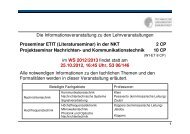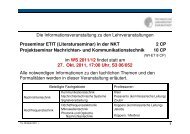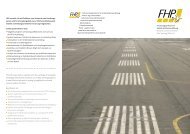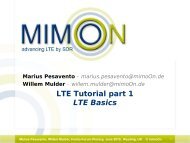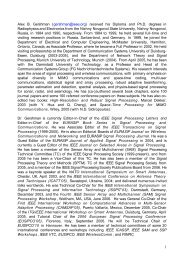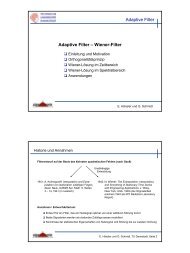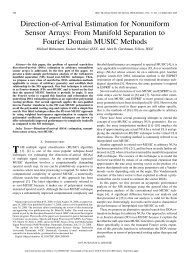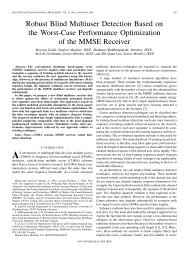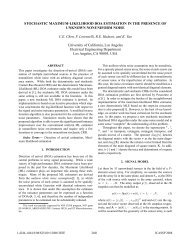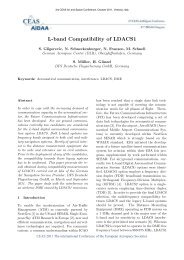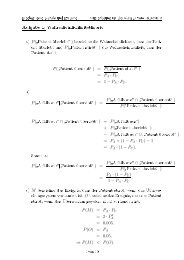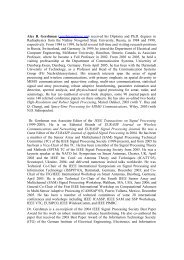Cooperative Zero Forcing in Multi-Pair Multi-Relay Networks
Cooperative Zero Forcing in Multi-Pair Multi-Relay Networks
Cooperative Zero Forcing in Multi-Pair Multi-Relay Networks
Create successful ePaper yourself
Turn your PDF publications into a flip-book with our unique Google optimized e-Paper software.
R. SivaSiva Ganesan, H. Al-Shatri, T. Weber and A. Kle<strong>in</strong>, ”<strong>Cooperative</strong> <strong>Zero</strong> <strong>Forc<strong>in</strong>g</strong> <strong>in</strong><br />
<strong>Multi</strong>-<strong>Pair</strong> <strong>Multi</strong>-<strong>Relay</strong> <strong>Networks</strong>,” <strong>in</strong> Proc. International Symposium on Personal, Indoor and<br />
Mobile Radio Communications, Sep. 2012.<br />
c○2008 IEEE. Personal use of this material is permitted. However, permission to<br />
repr<strong>in</strong>t/republish this material for advertis<strong>in</strong>g or promotional purposes or for creat<strong>in</strong>g<br />
new collective works for resale or redistribution to servers or lists, or to reuse any copyrighted<br />
component of this works must be obta<strong>in</strong>ed from the IEEE.
<strong>Cooperative</strong> <strong>Zero</strong> <strong>Forc<strong>in</strong>g</strong> <strong>in</strong> <strong>Multi</strong>-<strong>Pair</strong> <strong>Multi</strong>-<strong>Relay</strong><br />
<strong>Networks</strong><br />
Rakash SivaSiva Ganesan ∗ , Husse<strong>in</strong> Al-Shatri † , Tobias Weber † and Anja Kle<strong>in</strong> ∗<br />
∗ Communication Eng<strong>in</strong>eer<strong>in</strong>g Lab, Technische Universität Darmstadt, Merckstrasse 25, 64283 Darmstadt, Germany,<br />
† Institute of Communications Eng<strong>in</strong>eer<strong>in</strong>g, University of Rostock, Richard-Wagner-Strasse 31, 18119 Rostock, Germany,<br />
{r.ganesan, a.kle<strong>in</strong>}@nt.tu-darmstadt.de, {husse<strong>in</strong>.al-shatri, tobias.weber}@uni-rostock.de<br />
Abstract—In this paper, unidirectional communication between<br />
K half-duplex node pairs is considered. The source nodes have N<br />
antennas each and the dest<strong>in</strong>ation nodes have M antennas each.<br />
There is no direct l<strong>in</strong>k between the source and the dest<strong>in</strong>ation<br />
nodes. Q half-duplex relays, each with R antennas, assist <strong>in</strong><br />
the communication. It is assumed that the relays do not have<br />
enough antennas to spatially separate the data streams and hence,<br />
transceive zero forc<strong>in</strong>g cannot be performed at the relays. In this<br />
paper, we propose a scheme <strong>in</strong> which the source nodes and the<br />
relays cooperate <strong>in</strong> choos<strong>in</strong>g their precod<strong>in</strong>g matrices and the filter<br />
coefficients, respectively, to perform a cooperative zero forc<strong>in</strong>g. A<br />
closed form solution is proposed and the feasibility condition is<br />
derived. Simulation results show that the proposed cooperative<br />
zero forc<strong>in</strong>g scheme achieves more degrees of freedom and hence,<br />
achieves higher sum rate as compared to reference schemes.<br />
Index Terms—zero forc<strong>in</strong>g, one-way relay<strong>in</strong>g, multiple relays,<br />
<strong>in</strong>terference alignment<br />
I. INTRODUCTION<br />
When there is no direct l<strong>in</strong>k between the source and the<br />
dest<strong>in</strong>ation nodes, relays can be employed to aid the communication.<br />
In this paper, we focus on one-way relay<strong>in</strong>g with<br />
amplify and forward [1] half-duplex relays. In [2], it has<br />
been shown that a s<strong>in</strong>gle relay with R ≥ K antennas can<br />
support the communication between K source nodes and K<br />
dest<strong>in</strong>ation nodes when the source and dest<strong>in</strong>ation nodes have<br />
s<strong>in</strong>gle antennas. The relay performs multiuser beamform<strong>in</strong>g [2].<br />
This beamform<strong>in</strong>g is a comb<strong>in</strong>ation of receive beamform<strong>in</strong>g <strong>in</strong><br />
the first time slot and transmit beamform<strong>in</strong>g <strong>in</strong> the second time<br />
slot. The relay spatially separates the data streams based on<br />
the zero forc<strong>in</strong>g (ZF) or m<strong>in</strong>imum mean square error (MMSE)<br />
criterion. Therefore, the relay needs at least K antennas [2]. If<br />
multiple antennas at the source and the dest<strong>in</strong>ation nodes are<br />
considered, then each source node can transmit d data streams<br />
to its dest<strong>in</strong>ation node. In order to spatially separate these Kd<br />
data streams, at least R ≥ Kd antennas are required at the<br />
relay.<br />
<strong>Multi</strong>user beamform<strong>in</strong>g with multiple relays is considered<br />
<strong>in</strong> [1]–[5]. In [1]–[4], the nodes and the relays have a s<strong>in</strong>gle<br />
antenna each. In [1], [2], the relay coefficients are chosen<br />
such that at the dest<strong>in</strong>ation nodes, the <strong>in</strong>ter-pair <strong>in</strong>terference<br />
is completely suppressed. At least Q > K(K − 1) relays<br />
are required for an <strong>in</strong>terference-free communication. The relay<br />
Rakash SivaSiva Ganesan and Anja Kle<strong>in</strong> are <strong>in</strong>volved <strong>in</strong> the LOEWE<br />
Priority Program Cocoon (www.cocoon.tu-darmstadt.de).<br />
coefficients <strong>in</strong> [3] are used for m<strong>in</strong>imiz<strong>in</strong>g the mean squared<br />
error and <strong>in</strong> [4] to m<strong>in</strong>imize the relay power subject to a signal<br />
to <strong>in</strong>terference plus noise ratio (SINR) constra<strong>in</strong>t. In [5], the<br />
nodes have N antennas each and transmit d = N data streams<br />
to the dest<strong>in</strong>ation. Each of the Q relays requires R ≥ Kd<br />
antennas to completely remove the <strong>in</strong>ter-pair <strong>in</strong>terference at the<br />
dest<strong>in</strong>ations.<br />
In all the methods described <strong>in</strong> [1]–[5], a sufficient number<br />
of s<strong>in</strong>gle antenna relays or sufficient antennas at each relay<br />
are necessary to spatially separate the data streams and, hence,<br />
completely suppress <strong>in</strong>terference at the dest<strong>in</strong>ation nodes. The<br />
source nodes do not help the relay <strong>in</strong> zero forc<strong>in</strong>g the <strong>in</strong>terference<br />
at the dest<strong>in</strong>ation nodes. If the source nodes cooperate<br />
with the relays <strong>in</strong> choos<strong>in</strong>g the transmit precoders and the<br />
relay process<strong>in</strong>g matrices, then a smaller number R < Kd<br />
of antennas as compared to the case without the cooperation<br />
is required at the relay. This means that for a given number<br />
of antennas at the relays and at the source nodes, now more<br />
users can be supported through the cooperation between the<br />
source and the relay nodes. In [6], a generalized iterative<br />
method to design the precoders, relay process<strong>in</strong>g matrices and<br />
the receive filters jo<strong>in</strong>tly is given. These three matrices are<br />
designed one after another by sett<strong>in</strong>g the other two constant. In<br />
this case, QR ≥ Kd is sufficient to suppress the <strong>in</strong>terference<br />
at the dest<strong>in</strong>ations if the source and dest<strong>in</strong>ation nodes have<br />
multiple antennas to help the relay <strong>in</strong> suppress<strong>in</strong>g the <strong>in</strong>terpair<br />
<strong>in</strong>terference. However, the algorithm <strong>in</strong> [6] is an iterative<br />
scheme which converges to a local optimum and dur<strong>in</strong>g each<br />
iteration, a set of convex optimization problems has to be solved<br />
which <strong>in</strong>volves large computational complexity. A closed form<br />
solution for zero forc<strong>in</strong>g the <strong>in</strong>terference at the dest<strong>in</strong>ation<br />
nodes through the cooperation between the source and the relay<br />
nodes is not available <strong>in</strong> the literature.<br />
In this paper, we propose a cooperative zero forc<strong>in</strong>g scheme<br />
<strong>in</strong> which the source nodes help the relays to suppress <strong>in</strong>terpair<br />
<strong>in</strong>terference at the dest<strong>in</strong>ation nodes. In other words, the<br />
source nodes help the relay to perform transceive zero forc<strong>in</strong>g.<br />
We assume that the dest<strong>in</strong>ation nodes have M = d antennas, so<br />
that the dest<strong>in</strong>ation nodes can spatially separate d data streams,<br />
but do not have additional dimensions to suppress <strong>in</strong>ter-pair <strong>in</strong>terference.<br />
A closed form solution is proposed to determ<strong>in</strong>e the<br />
source precoders and relay process<strong>in</strong>g matrices. The feasibility<br />
condition is also derived <strong>in</strong> terms of N, Q, R, K and d.
Fig. 1. K-pair one-way relay network<br />
The organization of the paper is as follows. The system<br />
model is <strong>in</strong>troduced <strong>in</strong> Section II. In Section III-A, the concept<br />
of transceive zero forc<strong>in</strong>g is briefly expla<strong>in</strong>ed. The proposed<br />
cooperative zero forc<strong>in</strong>g scheme is then described <strong>in</strong> III-B.<br />
Section IV evaluates the performance of the proposed schemes<br />
<strong>in</strong> terms of the sum rate of the system. Section V concludes<br />
the paper.<br />
We use lower case letters for scalars and lower case bold<br />
letters and upper case bold letters to denote column vectors<br />
and matrices, respectively. (.) ∗ and (.) H denote the complex<br />
conjugate and complex conjugate transpose of the element<br />
with<strong>in</strong> the brackets, respectively.<br />
II. SYSTEM MODEL<br />
Figure 1 shows a K-pair one-way relay network. Each of<br />
the source nodes Si wants to transmit d data streams to its<br />
dest<strong>in</strong>ation node Di, for i = 1,2, ...,K. There is no direct<br />
l<strong>in</strong>k between the source and the dest<strong>in</strong>ation nodes. The source<br />
nodes have N ≥ d antennas each and the dest<strong>in</strong>ation nodes<br />
have M = d antennas and hence, the dest<strong>in</strong>ation nodes can<br />
spatially separate d data streams, but cannot aid the relays <strong>in</strong><br />
suppress<strong>in</strong>g the <strong>in</strong>terference. There are Q relays. All the nodes<br />
and the relays are assumed to be half-duplex. Each relay has<br />
R antennas where it is assumed that R < Kd. If R ≥ Kd,<br />
transceive zero forc<strong>in</strong>g could be performed at each relay [5].<br />
In the first time slot, the source nodes transmit the signal to the<br />
relays and <strong>in</strong> the second time slot, after l<strong>in</strong>ear signal process<strong>in</strong>g,<br />
the relays forward the signals to the dest<strong>in</strong>ation nodes. The<br />
relays and the source nodes can cooperate <strong>in</strong> choos<strong>in</strong>g their<br />
signal process<strong>in</strong>g matrices and precod<strong>in</strong>g matrices, respectively,<br />
but they do not share their signals. Let dj and Vj denote the<br />
data symbols and the precod<strong>in</strong>g matrix, respectively, of source<br />
node Sj. Let Hqj denote the <strong>Multi</strong>ple Input <strong>Multi</strong>ple Output<br />
(MIMO) channel between source node Sj and relay q. The<br />
noise at relay q is denoted by the vector n1q. The components<br />
of the noise vector n1q are i.i.d. complex Gaussian random<br />
variables which follow CN(0, σ2 1 ). The signal received at relay<br />
q is given by<br />
K<br />
xq = HqjVjdj + n1q. (1)<br />
j=1<br />
Amplify and Forward (AF) relay<strong>in</strong>g is assumed. The relay<br />
q multiplies the received signal with the relay process<strong>in</strong>g<br />
matrix Gq and forwards the result<strong>in</strong>g signal sq = Gqxq.<br />
Let s = sH 1 . .. sH H. Q The relays have a sum power<br />
constra<strong>in</strong>t def<strong>in</strong>ed by trace ssH ≤ PQ, where PQ is the total<br />
transmit power available at the relays. Let n2k denote the<br />
noise at the dest<strong>in</strong>ation node Dk. The components of the noise<br />
vector n2k are i.i.d. complex Gaussian random variables which<br />
follow CN(0, σ2 2). The received signal at dest<strong>in</strong>ation node Dk<br />
is denoted by<br />
⎛<br />
⎞<br />
Q K<br />
ˆdk = ⎝<br />
⎠ + n2k, (2)<br />
q=1<br />
F H kqGq<br />
j=1<br />
HqjVjdj + n1q<br />
where FH kq is the matrix denot<strong>in</strong>g the channel between relay<br />
q and dest<strong>in</strong>ation node Dk. Let nk = Q q=1 FH kqGqn1q + n2k<br />
denote the effective noise at dest<strong>in</strong>ation node Dk. Equation (2)<br />
can be rewritten as<br />
Q<br />
ˆdk =<br />
+<br />
q=1<br />
F H kqGqHqkVkdk<br />
Q<br />
q=1 FH kq Gq<br />
K<br />
j=1,j=k HqjVjdj + nk. (3)<br />
In the above equation, the first and the second terms correspond<br />
to the useful and the <strong>in</strong>terference signals, respectively. Let<br />
⎡ ⎤<br />
Hj =<br />
⎢<br />
⎣<br />
H1j<br />
.<br />
HQj<br />
⎥<br />
⎦, F H k = F H k1 . .. F H kQ<br />
⎡<br />
G1<br />
⎢ 0<br />
G = ⎢ .<br />
⎣ .<br />
0<br />
G2<br />
. ..<br />
. ..<br />
0<br />
0<br />
.<br />
⎤<br />
⎥<br />
⎦<br />
0 . .. 0 GQ<br />
for j = 1,2...K and k = 1,2...K. Then, (3) can be written<br />
as<br />
ˆdk = F H kGHkVkdk + F H K<br />
kG HjVjdj + nk. (4)<br />
j=1,j=k<br />
Let Wkj = F H k GHjVj. Assum<strong>in</strong>g that the <strong>in</strong>put symbols<br />
denoted by the elements of the vector dk are <strong>in</strong>dependent and<br />
zero mean complex Gaussian distributed with variance one, the<br />
achievable rate with which node Dk can transmit is given by<br />
Rk = 1<br />
2 log <br />
⎛<br />
K<br />
<br />
2 I<br />
+ ⎝ WkjW<br />
<br />
j=1,j=k<br />
H ⎞−1<br />
kj + R ⎠ WkkW<br />
nn<br />
H <br />
<br />
<br />
<br />
kk<br />
<br />
<br />
(5)<br />
where R is the covariance matrix of the effective noise nk.<br />
nn<br />
III. TRANSCEIVE ZERO FORCING<br />
A. Introduction to Transceive <strong>Zero</strong> <strong>Forc<strong>in</strong>g</strong><br />
In this section the concept of transceive zero forc<strong>in</strong>g [7] is<br />
expla<strong>in</strong>ed. The receive signatures of the signal from the j th<br />
source node at the relays are given by HjVj. In order to<br />
spatially separate the signals <strong>in</strong> the QR dimensional relays<br />
,
space, comb<strong>in</strong>ed receive zero forc<strong>in</strong>g has to be done at the<br />
relays. The receive zero forc<strong>in</strong>g matrix GRx is given by<br />
GRx = +<br />
H1V1 H2V2 . .. HKVK . (6)<br />
Here + denotes the pseudo-<strong>in</strong>verse. Then the relays need to<br />
perform transmit zero forc<strong>in</strong>g to transmit the signals <strong>in</strong>terference<br />
free to the dest<strong>in</strong>ations. The transmit zero forc<strong>in</strong>g matrix<br />
GTx is given by<br />
⎡<br />
⎢<br />
GTx = ⎢<br />
⎣<br />
FH 1<br />
FH 2<br />
.<br />
FH K<br />
⎤<br />
⎥<br />
⎦<br />
+<br />
. (7)<br />
The columns of the matrix GTx correspond to the transmit signatures<br />
of the relay signals. The receive zero forc<strong>in</strong>g followed<br />
by the transmit zero forc<strong>in</strong>g is called transceive zero forc<strong>in</strong>g<br />
and is denoted by the matrix<br />
G = GTxGRx. (8)<br />
Note that, when the precod<strong>in</strong>g vectors Vj are chosen arbitrarily,<br />
it cannot be guaranteed that the matrix G is block-diagonal.<br />
However, we can design the the precod<strong>in</strong>g matrices Vj for<br />
j = 1,2, ...,K and hence, the receive signatures HjVj such<br />
that G is block-diagonal.<br />
B. <strong>Cooperative</strong> <strong>Zero</strong> <strong>Forc<strong>in</strong>g</strong> Scheme<br />
In this section, the proposed cooperative zero forc<strong>in</strong>g scheme<br />
is described. The ma<strong>in</strong> idea is as follows: The relays alone<br />
cannot perform transceive zero forc<strong>in</strong>g due to the block diagonal<br />
structure of the matrix G. The nodes cooperate with<br />
the relays <strong>in</strong> choos<strong>in</strong>g their precod<strong>in</strong>g matrices to achieve<br />
zero <strong>in</strong>terference at the dest<strong>in</strong>ation nodes. Perfect channel<br />
knowledge is assumed at the source nodes and at the relays.<br />
For zero <strong>in</strong>terference at the dest<strong>in</strong>ation nodes, the relay should<br />
transmit the signal from source node Dj <strong>in</strong> a direction perpendicular<br />
to the channels of all the other K − 1 dest<strong>in</strong>ation<br />
nodes. These transmission directions also called the transmit<br />
zero forc<strong>in</strong>g directions or the transmit signatures are given<br />
by the columns of the matrix GTx. For any given choice of<br />
precod<strong>in</strong>g matrices Vj for j = 1, ...,K, the signals received<br />
at the relays are <strong>in</strong> the directions given by the columns of the<br />
W = H1V1 . .. HKVK<br />
. The relays with the block-<br />
diagonal matrix G should perform a l<strong>in</strong>ear transformation that<br />
maps the receive signatures to the transmit signature <strong>in</strong> a<br />
QR dimensional space. Due to the block-diagonal structure<br />
of the matrix G, the number of variable <strong>in</strong> the matrix G is<br />
QR 2 . Hence, only R receive signatures can be mapped to<br />
their correspond<strong>in</strong>g desired transmit zero forc<strong>in</strong>g directions.<br />
Fortunately, matrix G is a full rank matrix. This means the other<br />
Kd − R receive signatures map to some l<strong>in</strong>early <strong>in</strong>dependent<br />
directions, but not necessarily to the desired transmit signatures.<br />
By modify<strong>in</strong>g the precod<strong>in</strong>g matrices at the source nodes, the<br />
receive signatures can be altered. In the proposed scheme,<br />
the sources have sufficient number of antennas so that the<br />
precod<strong>in</strong>g vectors can be chosen such that design<strong>in</strong>g the l<strong>in</strong>ear<br />
transformation for the first R receive signatures also maps<br />
the other Kd − R receive signatures to their desired transmit<br />
zero forc<strong>in</strong>g directions. The number of antennas required at<br />
the source nodes is derived later. The cooperative zero forc<strong>in</strong>g<br />
is performed <strong>in</strong> two steps. First, the precoders are designed.<br />
Second, the l<strong>in</strong>ear signal process<strong>in</strong>g matrices G1,G2, ...,GQ<br />
are determ<strong>in</strong>ed.<br />
1) Transmit Precoders: In this section, the precoders at the<br />
source nodes are designed such that when the relay performs<br />
transceive zero forc<strong>in</strong>g for the first R data streams, all the other<br />
Kd − R data streams are automatically transceive zero forced.<br />
Let the columns of the matrix<br />
GTx = Z1 . .. ZK<br />
⎡<br />
⎢<br />
= ⎢<br />
⎣<br />
FH 1<br />
FH 2<br />
.<br />
FH K<br />
⎤<br />
⎥<br />
⎦<br />
+<br />
(10)<br />
denote the transmit signatures. It has to be noted that if<br />
we assume i.i.d. MIMO channel model [8] and <strong>in</strong>dependent<br />
dest<strong>in</strong>ation nodes, then Zj for j = 1,2, ...,K obta<strong>in</strong>ed from<br />
(10) has rank d with a probability of one. The receive signatures<br />
at the relay are given by W = H1V1 . .. HKVK<br />
. The<br />
objective is to design the matrices Vj for j = 1,2, ...,K such<br />
that<br />
GTx = GW (11)<br />
is satisfied for a block-diagonal matrix G. The transmit-receive<br />
signature pair correspond<strong>in</strong>g to node-pair j can be written as<br />
Zj = GHjVj<br />
(12)<br />
for j = 1,2, ...,K. Equation (12) means that the receive<br />
signatures HjVj are mapped to the transmit signatures Zj. In<br />
general, only the subspace spanned by the receive signatures<br />
HjVj needs to be equal to the subspace spanned by the<br />
transmit signatures Zj to achieve zero <strong>in</strong>terference at the<br />
dest<strong>in</strong>ation nodes. Equation (12) can be written <strong>in</strong> terms of<br />
the l<strong>in</strong>ear signal process<strong>in</strong>g matrices of each relay as<br />
⎡<br />
⎢<br />
⎣<br />
Z 1 j<br />
Z 2 j<br />
.<br />
.<br />
Z Q<br />
j<br />
⎤<br />
⎥<br />
⎦ =<br />
⎡<br />
G1<br />
⎢ 0<br />
⎢ .<br />
⎣ .<br />
0<br />
G2<br />
. ..<br />
. ..<br />
0<br />
0<br />
.<br />
⎤⎡<br />
⎥⎢<br />
⎥⎢<br />
⎥⎢<br />
⎦⎣<br />
0 . .. 0 GQ<br />
for j = 1,2, ...,K. Here, Z q<br />
j<br />
H1j<br />
H2j<br />
.<br />
HQj<br />
⎤<br />
⎥<br />
⎦ Vj (13)<br />
corresponds to the d transmit<br />
signatures of the qth relay. As each of the relay spans an<br />
R dimensional signal space and R < Kd, the Kd transmit<br />
signatures Z q<br />
1 . .. Z q <br />
th of the q relay will be l<strong>in</strong>early<br />
K<br />
dependent on each other. Let n = R/d. Then R = nd<br />
transmit signatures will be l<strong>in</strong>early <strong>in</strong>dependent of each other<br />
and the other Kd − R transmit signatures will be l<strong>in</strong>early<br />
dependent on the first nd transmit signatures. In general, ⌊n⌋ d<br />
transmit signatures correspond to ⌊n⌋ dest<strong>in</strong>ation nodes and<br />
the other (n − ⌊n⌋) d transmit signatures correspond to the<br />
(⌊n⌋ + 1) th dest<strong>in</strong>ation node. For simplicity, throughout the<br />
rest of the paper we assume R to be an <strong>in</strong>teger multiple of<br />
d. Then the transmit signatures correspond<strong>in</strong>g to n dest<strong>in</strong>ation
⎡ <br />
1T C1n+1 ⊗ H11<br />
⎢ .<br />
⎢ .<br />
⎢<br />
.<br />
⎢ C<br />
⎢<br />
⎣<br />
. ..<br />
<br />
1T Cnn+1 ⊗ H1n<br />
<br />
T − I ⊗ H1n+1 0 · · · 0<br />
.<br />
QT<br />
<br />
1n+1 ⊗ HQ1 . ..<br />
<br />
C QT<br />
<br />
nn+1 ⊗ HQn − IT .<br />
<br />
.<br />
C<br />
<br />
⊗ HQn+1 0 · · · 0<br />
.<br />
QT<br />
<br />
1K ⊗ HQ1 . ..<br />
<br />
C QT<br />
<br />
nK ⊗ HQn 0 . .. 0 − IT <br />
S<br />
⎤<br />
⎥⎡<br />
⎥<br />
⎥⎢<br />
⎥⎢<br />
⎥⎢<br />
⎥⎣<br />
⎥<br />
⎦<br />
⊗ HQK<br />
<br />
nodes will be l<strong>in</strong>early <strong>in</strong>dependent of each other and the<br />
transmit signatures correspond<strong>in</strong>g to the other K−n dest<strong>in</strong>ation<br />
nodes can be written as a l<strong>in</strong>ear comb<strong>in</strong>ation of the transmit<br />
signatures correspond<strong>in</strong>g to the first n dest<strong>in</strong>ation nodes. This<br />
is represented by<br />
Z q<br />
i = Z q<br />
1 . .. Z q n<br />
T q<br />
txi<br />
(14)<br />
where T q<br />
txi for q = 1,2, ...,Q and i = n + 1, n +<br />
2, ...,K gives the l<strong>in</strong>ear dependence relation between Z q<br />
i<br />
and Z q<br />
1 . .. Zq <br />
n . Similarly, the l<strong>in</strong>ear dependency of the<br />
receive signatures can be denoted by<br />
HqiVi = Hq1V1 . .. HqnVn<br />
T q<br />
rxi<br />
(15)<br />
for i = n+1, ...,K. Without loss of generality, we will assume<br />
that the matrices G1,G2, ...,GQ will be chosen such that the<br />
first R columns of the matrix equality <strong>in</strong> Equation (11) will<br />
be satisfied. That is, the matrix G maps the first R receive<br />
signatures to the first R transmit signatures. This is given by<br />
Z q<br />
l<br />
= GqHqlVl<br />
(16)<br />
for q = 1,2, ...,Q and l = 1,2, ...,n. The other Kd − R<br />
receive signatures will be mapped to the correspond<strong>in</strong>g Kd−R<br />
transmit signatures if and only if<br />
Z q<br />
i = GqHqiVi<br />
(17)<br />
holds for q = 1,2, ...,Q and i = n + 1, n + 2, ...,K.<br />
The matrices Gq for q = 1,2...Q denote a set of l<strong>in</strong>ear<br />
transformations and hence, <strong>in</strong> order to satify (17),<br />
T q<br />
txi = Tqrxi<br />
(18)<br />
need to hold for q = 1,2, ...,Q and i = n + 1, n + 2, ...,K.<br />
From (14), (15) and (18), we get<br />
HqiVi = Hq1V1 . .. HqnVn<br />
q<br />
Z1 . .. Zq −1 q<br />
n Zi .<br />
(19)<br />
Let ⎡ ⎤<br />
⎢<br />
⎣<br />
C q<br />
1i<br />
.<br />
.<br />
C q<br />
ni<br />
Then, (19) can be written as<br />
⎥<br />
⎦ = Z q<br />
1 . .. Z q n<br />
HqiVi = Hq1V1 . .. HqnVn<br />
−1 q<br />
Zi . (20)<br />
⎡<br />
⎢<br />
⎣<br />
C q<br />
1i<br />
.<br />
.<br />
C q<br />
ni<br />
⎤<br />
⎥<br />
⎦. (21)<br />
vec (V1)<br />
vec (V2)<br />
.<br />
vec (VK)<br />
⎤<br />
⎥ = 0 (23)<br />
⎦<br />
Vectoriz<strong>in</strong>g the matrices on both sides of (21) and apply<strong>in</strong>g the<br />
property vec (AXB) = BT ⊗ A vec (X), we get<br />
<br />
T<br />
I ⊗ Hqi vec (Vi) = C qT<br />
<br />
1i ⊗ Hq1 vec (V1) + . ..<br />
<br />
+ C qT<br />
<br />
ni ⊗ Hqn vec (Vn) (22)<br />
for q = 1,2, ...,Q and i = n + 1, n + 2, ...,K. Here, ⊗<br />
denotes the Kronecker product. Equation (22) is a system of<br />
l<strong>in</strong>ear homogeneous equations which can be written as given <strong>in</strong><br />
(23). The dimension of matrix S is (Kd −R)QR ×KNd. The<br />
number of rows and columns denotes the number of equations<br />
and variables, respectively, <strong>in</strong> (23). A non-trivial solution for<br />
(23) exists when the number of variables is greater than the<br />
number of equations. This is given by<br />
KNd > (Kd − R)QR. (24)<br />
Equation (24) gives the feasibility condition for the proposed<br />
cooperative zero forc<strong>in</strong>g scheme. It has to be noted Zj for<br />
j = 1,2, ...,K obta<strong>in</strong>ed from (10) has rank d with a probability<br />
of one. Hence, (13) guarantees that Vj for j = 1,2, ...,K<br />
is of rank d. Also, note that the number N of antennas<br />
required at each source node is directly proportional to the<br />
number of relays. This is due to the fact that when the number<br />
of relays <strong>in</strong>creases, the dimension of the space where the<br />
l<strong>in</strong>ear transformation is performed also <strong>in</strong>creases. Hence, more<br />
variables are required at the source nodes to satisfy (18). In<br />
this paper, we assume that Q is equal to the m<strong>in</strong>imum number<br />
of relays required to satisfy the condition QR ≥ Kd. That is<br />
QR ≥ Kd > (Q − 1)R. If there are Q ′ > Q relays available<br />
<strong>in</strong> the system, the extra Q ′ − Q relays will be switched off.<br />
For particular <strong>in</strong>teger values of R,N,d, K and Q, (24) can<br />
be satisfied only with strict <strong>in</strong>equality. In this case, there is a<br />
possibility to choose the transmit precoder matrices from the<br />
solution space of (23). Let the span of the columns of the matrix<br />
A = A T 11 A T 12 · · · A T 1d · · · A T Kd<br />
T = null(S)<br />
(25)<br />
denote the solution space, then the m th column of the precod<strong>in</strong>g<br />
matrix Vj is obta<strong>in</strong>ed as<br />
vjm = Ajmt, (26)<br />
where vector vjm is a l<strong>in</strong>ear comb<strong>in</strong>ation of the columns of the<br />
matrix Aj def<strong>in</strong>ed by the vector t. Any arbitrary choice of t
is a solution for (23). The vector t can be chosen to maximize<br />
a given objective function. For example, t can be chosen such<br />
that the total signal power received at the relays is maximized.<br />
That is<br />
topt =argmax<br />
t<br />
K<br />
d<br />
j=1 m=1<br />
t H A H jm HH j HjAjmt<br />
t H A H jm Ajmt<br />
. (27)<br />
The optimization problem described <strong>in</strong> (27) is non-convex [9]<br />
and gradient based methods described <strong>in</strong> [10] can be used to<br />
f<strong>in</strong>d the local maxima. In [10], it has been shown that the local<br />
maxima provides a significant ga<strong>in</strong> <strong>in</strong> terms of the sum rate<br />
when compared to an arbitrary choice of t.<br />
In order to satisfy the transmit power constra<strong>in</strong>t at each node,<br />
the precoder matrices need to be normalized based on the total<br />
power available at each node. When the precoders are multipled<br />
by some scalars, the correspond<strong>in</strong>g transmit signatures also<br />
have to be multiplied by the correspond<strong>in</strong>g scalars so that (18)<br />
holds. Let Pt denote the transmit power available at each node.<br />
Assume uniform power allocation across the d data streams.<br />
Then the precoders are normalized as follows:<br />
V norm<br />
j<br />
=<br />
<br />
Pt<br />
d Vj<br />
1<br />
H − 2 Diag Vj Vj<br />
(28)<br />
where Diag(.) replaces all off-diagonal elements of the matrix<br />
with<strong>in</strong> the brackets by zeros. For (18) to hold, the transmit<br />
signatures have to be normalized as follows:<br />
Z norm<br />
j<br />
=<br />
<br />
Pt<br />
d Zj<br />
1<br />
H − 2 Diag Vj Vj<br />
(29)<br />
for j = 1,2, ...,K.<br />
2) <strong>Relay</strong> Process<strong>in</strong>g Matrices: In this section, the relay process<strong>in</strong>g<br />
matrices G1,G2, ...,GQ are determ<strong>in</strong>ed. In Section<br />
III-B1, the precoders have been designed such that if the relays<br />
map the first R receive signatures to the first R transmit zero<br />
forc<strong>in</strong>g directions, then the other Kd − R receive signatures<br />
will be automatically mapped to their correspond<strong>in</strong>g Kd − R<br />
transmit zero forc<strong>in</strong>g directions. In order for the relays to map<br />
the first R receive signatures to the first R transmit signatures,<br />
the follow<strong>in</strong>g equation should hold:<br />
q<br />
Z1 . .. Zq <br />
n = Gq Hq1V1 . .. HqnVn (30)<br />
for q = 1,2, ...,Q. Therefore<br />
Gq = Z q<br />
1 . .. Zq −1 n Hq1V1 . .. HqnVn .<br />
(31)<br />
The relays have a total transmit power constra<strong>in</strong>t. The matrix G<br />
can be scaled to satisfy this power constra<strong>in</strong>t without disturb<strong>in</strong>g<br />
the zero forc<strong>in</strong>g solutions. Note that the optimization problem<br />
described <strong>in</strong> (27) is used only to optimize over the many<br />
possible solutions. For the cooperative zero forc<strong>in</strong>g problem, we<br />
need only one arbitrary zero forc<strong>in</strong>g solution and the method<br />
described above provides a closed form solution. Hence, the<br />
computational complexity is very low compared to [6].<br />
Interference alignment <strong>in</strong> the reciprocal network: Also<br />
for the case that the transmitters have M = d antennas and the<br />
receivers have N antennas, the proposed method can be used to<br />
achieve <strong>in</strong>terference-free transmission. In this case, the relays<br />
cooperate with the dest<strong>in</strong>ation nodes to perform <strong>in</strong>terference<br />
alignment at the dest<strong>in</strong>ation nodes. It has to be noted that the<br />
source nodes do not need any channel knowledge and the relays<br />
receive the l<strong>in</strong>ear comb<strong>in</strong>ation of the signals from the source<br />
nodes. Each of the relays cannot decode the signals itself, but<br />
the relays can cooperate with each other to perform <strong>in</strong>terference<br />
alignment at the dest<strong>in</strong>ation nodes, mak<strong>in</strong>g it possible for the<br />
dest<strong>in</strong>ation nodes to decode the useful signal. To obta<strong>in</strong> the<br />
<strong>in</strong>terference alignment solution, first the network is converted<br />
<strong>in</strong>to its reciprocal network with N antennas at the transmitter<br />
and M antennas at the receivers, with the channel between the<br />
source nodes and the relay nodes given by the Hermitian of the<br />
correspond<strong>in</strong>g channel between the relays and the dest<strong>in</strong>ation<br />
nodes <strong>in</strong> the orig<strong>in</strong>al network. The channel between the relays<br />
and the dest<strong>in</strong>ation nodes <strong>in</strong> the reciprocal network is given<br />
by the Hermitian of the correspond<strong>in</strong>g channel between the<br />
source and the relay nodes <strong>in</strong> the orig<strong>in</strong>al network. After this<br />
conversion, the proposed cooperative zero forc<strong>in</strong>g method can<br />
be used to obta<strong>in</strong> the source precoders and the relay process<strong>in</strong>g<br />
matrices of the reciprocal network. The relay process<strong>in</strong>g matrices<br />
and the receive zero forc<strong>in</strong>g matrices of the orig<strong>in</strong>al network<br />
are then given by the Hermitian of the correspond<strong>in</strong>g relay<br />
process<strong>in</strong>g matrices and the source precoders, respectively, <strong>in</strong><br />
the reciprocal network.<br />
IV. PERFORMANCE ANALYSIS<br />
In this section, the sum rate performance of the proposed<br />
cooperative zero forc<strong>in</strong>g (CZF) scheme is <strong>in</strong>vestigated. For<br />
the simulation, we consider a K = 3 node pairs scenario.<br />
Each source node wants to transmit d = 1 data stream to<br />
its dest<strong>in</strong>ation node. There are Q = 2 relays that assist <strong>in</strong><br />
the communication. Each of the source and relay nodes has<br />
N = R = 2 antennas. The dest<strong>in</strong>ation nodes have M = d = 1<br />
antenna. Accord<strong>in</strong>g to (24), this scenario is feasible. In total,<br />
three data streams are transmitted <strong>in</strong> two time slots. Two<br />
reference methods are considered to compare with the sum rate<br />
performance of the proposed CZF scheme. The first reference<br />
method (SVD ZF TDMA) is based on transceive zero forc<strong>in</strong>g<br />
[5] for a one way relay<strong>in</strong>g scenario. The source nodes transmit<br />
their data streams <strong>in</strong> the directions correspond<strong>in</strong>g to the largest<br />
s<strong>in</strong>gular values of the channel from the source node to the<br />
relays. The relays spatially separate the data streams and<br />
perform transceive zero forc<strong>in</strong>g. In this method, only two node<br />
pairs can be supported at a time, additional node pairs are<br />
separated by time division multiple access (TDMA). The ma<strong>in</strong><br />
difference between the CZF and SVD ZF TDMA scheme is<br />
that <strong>in</strong> CZF, the transmit precoders are used for <strong>in</strong>creas<strong>in</strong>g the<br />
number of degrees of freedom def<strong>in</strong>ed as the number of data<br />
streams <strong>in</strong> the system while <strong>in</strong> SVD ZF TDMA, the transmit<br />
precoders are used for a beamform<strong>in</strong>g ga<strong>in</strong>.<br />
The second reference method is based on iterative m<strong>in</strong>imization<br />
of the sum mean square error (IterativeMMSE) proposed<br />
<strong>in</strong> [6]. In this method, the transmit precoders, relay filters and<br />
receive filters are optimized iteratively. In this method, all the<br />
three node pairs transmit at the same time. 50 iterations are
Fig. 2. Sum rate performance for a 3 node pairs scenario with N = 2, R =<br />
2, Q = 2 and M = d = 1<br />
considered for the simulation. Simulation results show that<br />
typically after 50 iterations the residual MMSE converges to<br />
a small value and rema<strong>in</strong>s almost constant.<br />
Figure 2 shows the sum rate performance of each method<br />
as a function of P/σ 2 . P is the transmit power at each node<br />
<strong>in</strong> the CZF scheme and <strong>in</strong> the IterativeMMSE scheme. In the<br />
SVD ZF TDMA scheme, as the nodes are sometimes silent<br />
due the TDMA, the power available at each node is scaled<br />
to 3P/2 <strong>in</strong> order to have a fair comparison. The noise power<br />
at each node is assumed to be the same and is denoted by<br />
σ 2 = σ 2 1 = σ 2 2. The relays have a total transmit power 3P <strong>in</strong><br />
all three cases. The MIMO channel matrices between the nodes<br />
and the relay are normalized such that <strong>in</strong> the CZF scheme, on<br />
an average, the transmitted signal power is the same as the<br />
received signal power. The sum rate is calculated as an average<br />
value from 10 3 channel realizations generated randomly us<strong>in</strong>g<br />
the i.i.d. frequency-flat Rayleigh fad<strong>in</strong>g MIMO channel model<br />
[8]. The red curve <strong>in</strong> Figure 2 shows the performance of the<br />
proposed scheme. The vector t is arbitrarily chosen. The blue<br />
and the green dashed l<strong>in</strong>es correspond to the SVD ZF TDMA<br />
and IterativeMMSE schemes, respectively. It can be clearly seen<br />
that the proposed cooperative zero forc<strong>in</strong>g scheme outperforms<br />
both the reference schemes. At high SNR values, the slopes of<br />
CZF and SVD ZF TDMA correspond to the total number of<br />
data streams transmitted over two time slots but the sum rate<br />
of IterativeMMSE scheme converges to a f<strong>in</strong>ite value. This is<br />
due to the fact that the iterativeMMSE method obta<strong>in</strong>s only<br />
a local m<strong>in</strong>imum and hence, there is an <strong>in</strong>terference leakage.<br />
Furthermore, the correlations of the <strong>in</strong>terfer<strong>in</strong>g signals com<strong>in</strong>g<br />
through different relays are not considered <strong>in</strong> [6].<br />
Figure 3 shows the sum rate performance when K = 3, N =<br />
3, R = 4, Q = 2 and M = d = 2. From (24), it can be<br />
seen that this scenario is feasible. Note that for doubl<strong>in</strong>g the<br />
number of data streams, it is not necessary to double the number<br />
of antennas at each node. From Figure 3 it can be seen that<br />
CZF outperforms SVD ZF TDMA s<strong>in</strong>ce with CZF, 6 degrees<br />
of freedom are achieved while with SVD ZF TDMA, only 4<br />
degrees of freedom are achieved.<br />
V. CONCLUSION<br />
In this paper, one way relay<strong>in</strong>g <strong>in</strong> a K node pairs multiple<br />
relay scenario is considered. A cooperative zero forc<strong>in</strong>g<br />
Fig. 3. Sum rate performance for a 3 node pairs scenario with N = 3, R =<br />
4, Q = 2 and M = d = 2<br />
scheme, where the source nodes and the relay nodes cooperate<br />
to perform zero forc<strong>in</strong>g at the dest<strong>in</strong>ation nodes, is proposed.<br />
Through this cooperative method, zero <strong>in</strong>terference at each<br />
of the dest<strong>in</strong>ation nodes can be achieved. Less antennas are<br />
required at the relays compared to the case where the nodes<br />
and relays do not cooperate to perform zero forc<strong>in</strong>g. This means<br />
that for a given number of antennas at the nodes and the relays,<br />
more users can be supported compared to the case without the<br />
cooperation. The feasibility condition KNd > (Kd−R)QR is<br />
derived. The simulation results show that the proposed scheme<br />
achieves more degrees of freedom and hence, achieves higher<br />
sum rate <strong>in</strong> the system as compared to reference schemes.<br />
ACKNOWLEDGEMENT<br />
This work is funded by the Deutsche Forschungsgesellschaft<br />
(DFG) under Grant No. Kl907/5-1 and Grant No. WE2825/11-<br />
1.<br />
REFERENCES<br />
[1] B. Rankov and A. Wittneben, “Spectral efficient protocols for half-duplex<br />
fad<strong>in</strong>g relay channels,” IEEE Journal on Selected Areas <strong>in</strong> Communications,<br />
vol. 25, no. 2, pp. 379 –389, Feb. 2007.<br />
[2] S. Berger, M. Kuhn, A. Wittneben, T. Unger, and A. Kle<strong>in</strong>, “Recent advances<br />
<strong>in</strong> amplify-and-forward two-hop relay<strong>in</strong>g,” IEEE Communications<br />
Magaz<strong>in</strong>e, vol. 47, no. 7, pp. 50 –56, Jul. 2009.<br />
[3] S. Berger and A. Wittneben, “<strong>Cooperative</strong> Distributed <strong>Multi</strong>user MMSE<br />
<strong>Relay</strong><strong>in</strong>g <strong>in</strong> Wireless Ad-Hoc <strong>Networks</strong>,” <strong>in</strong> Proc. Asilomar Conference<br />
on Signals, Systems and Computers, Nov. 2005, pp. 1072 – 1076.<br />
[4] S. Fazeli-Dehkordy, S. Shahbazpanahi, and S. Gazor, “<strong>Multi</strong>ple Peer-to-<br />
Peer Communications Us<strong>in</strong>g a Network of <strong>Relay</strong>s,” IEEE Transactions<br />
on Signal Process<strong>in</strong>g, vol. 57, no. 8, pp. 3053 –3062, Aug. 2009.<br />
[5] O. Oyman and A. Paulraj, “Design and analysis of l<strong>in</strong>ear distributed<br />
MIMO relay<strong>in</strong>g algorithms,” IEE Proceed<strong>in</strong>gs Communications, vol. 153,<br />
no. 4, pp. 565 – 572, Aug 2006.<br />
[6] S. Ma, C. X<strong>in</strong>g, Y. Fan, Y.-C. Wu, T.-S. Ng, and H. Poor, “Iterative<br />
transceiver design for MIMO AF relay networks with multiple sources,”<br />
<strong>in</strong> Proc. Military Communications Conference, Nov. 2010, pp. 369 –374.<br />
[7] D. Tse and P. Viswanath, Fundamentals of Wireless Communication.<br />
Cambridge, UK: Cambridge, 2008.<br />
[8] A. Goldsmith, A. Paulraj, and H. V. Poor, MIMO Wireless Communications.<br />
Cambridge, UK: Cambridge, 2007.<br />
[9] S. Boyd and L. Vandenberghe, Convex Optimization. Cambridge, UK:<br />
Cambridge, 2004.<br />
[10] R. SivaSiva Ganesan and A. Kle<strong>in</strong>, “Projection based Space-Frequency<br />
Interference Alignment <strong>in</strong> a <strong>Multi</strong>-Carrier <strong>Multi</strong>-User Two-Way <strong>Relay</strong><br />
Network,” <strong>in</strong> Proc. International Symposium on Wireless Communication<br />
Systems, Nov. 2011.



